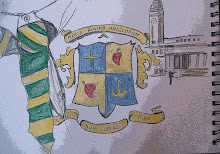*Except for Iraq and Afghanistan figures do not include those on non-active service, training or in accidents. So the only figures, which do include this information, are from Iraq and Afghanistan. The layout of the piece contains the key, showing what the red circles represent on the map. The larger red circle shows a bigger number of deaths. And the smaller the red circle shows a lesser number of deaths. As you can see from the key, only the toll for 1, 400 and 800 deaths is being represented. The difference between the sizes of these circles is very distinct and possibly to scale of each other because the 400 circle does seem half the size of the 800 circle. However, it is quite difficult to tell on the map the number of deaths within particular countries such as the Balkans and man & Dhofar because of the size of the red circles here. Being slightly bigger than the 1 but significantly smaller than the 400 circles, this leaves you to only be able to hazard a guess at the number of deaths it is representing.
However, we are shown to the left of the map and key the total number of deaths within the first and the second world wars, as well as the number of deaths in wars since 1945 (so after the second world war). Again, the actual figures for this are presented inside a poppy, which is obviously larger, the more deaths that have taken place. As you can see there were many more deaths in the First World War than the Second World War, but a significantly smaller figure since 1945 in comparison to the Second World War. I think the incorporation of the poppy into the information highlights to the audience that the information is about the remembrance of people who have died at war. The poppy is such a significant symbol in today’s society that people will recognise this and so there understanding of the information should be made easier.
I think perhaps the actual countries of the map could be made darker in colour because at first I was more drawn to the negative space thinking that it was a close up map. Perhaps if the outlines of the countries were darker this would make it slightly easier to read.



No comments:
Post a Comment